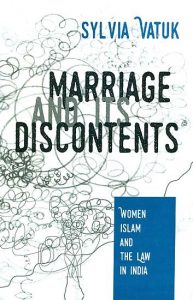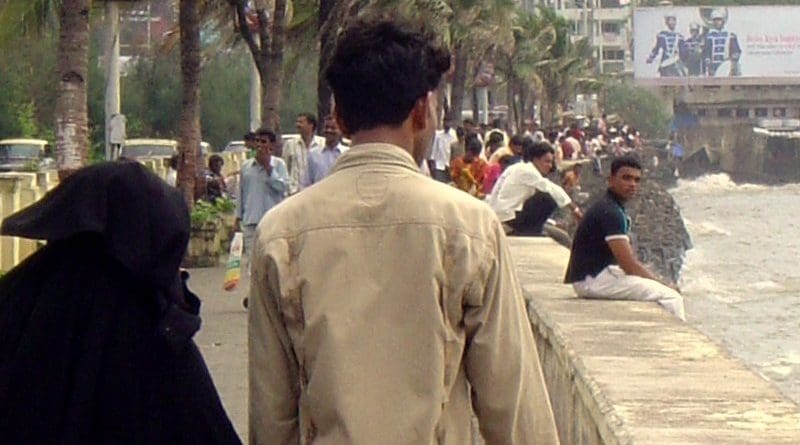Marriage And Its Discontents: Women, Islam And The Law In India – Review
The book Marriage and its Discontents: Women Islam and the Law in India by Sylvia Vatuk is an empirically rich work that discredits the very myth among masses of other religions that Islam is anti-social, anti-feminist, silent towards women and more precisely towards the matter of ‘Divorce’. It is a comprehensive study that brings out in detail how Muslim women negotiate about the Muslim personal law, family courts and extra-judicial options that can be used by women to come out of the marriage.
Her hard-hitting work based on ten years of research in Chennai and Hyderabad explored various options that Indian Muslim Women possess to walk out upon learning that the marriage is no longer going to work. Most interesting is that she didn’t limit herself to a particular institution, Law, Act or popular cases, but patiently studied minutes of Muslim Personal Law, Dowry, Dissolution of Muslim Marriage Act and the Muslim Women (Protection of Rights on Divorce) Act, along with conducting extensive interviews with government-appointed qazis in both cities; met and had detailed discussions with women themselves, as well as with lawyers, judges, counselors, court staff and advocates.

The author has beautifully tried to include the records of every registered case even if it has not caught eyes of media or scholars. Each chapter at the end provide references to other journals, books, court cases, explanation of various words like iddat, khula, mehr, etc and verdicts relevant to the topic that really enrich the book and reader will have no problem in understanding the meaning of the concepts used by the author.
The book is divided into eight chapters and each chapter is well explained and justifies the title of the book in terms of what happens when the marriage breaks up and the proceedings wherein the couple face each other in the judicial settings and the experiences of women to these non-state institutions. Further, the author tries to capture as to how the Muslim personal law impacts women’s efforts to enable them to overcome the constraints or obstacles when they approach to the civil and religious institutions.
The most interesting and readable part of the book is when she explains how women are treated under Muslim personal law and the role of non-state religious bodies in the administration of Islamic law in marital disputes. The book is useful for the students of law, social sciences and gender studies.
In the first chapter she argues that administration of laws on women generally follows ‘paternalistic’ approach and ‘compromise’ is a gender-linked concept especially she mentions about the functioning of Family courts wherein women were asked to withdraw criminal charges filed against their husbands along with other negotiations that goes in favor of men. The chapter revolves around the issue of power and resistance in relationship of individual to the law. Women, for granted, taken as weak, dependent creature for all basic needs throughout life, hence, whatever is done is less and ineffective because finally they need lifelong material and symbolic support and protection from men in their lives. She contested that although the Indian legal system is ‘pluralistic’ but in practice, Indian women could only use unofficial community or religious dispute-settlement bodies that too have their own limitations.
‘Triple talak’ allures local as well as foreign public too much that one often get to see strikes, demonstrations, deliberations at both formal and informal platform too. Therefore, in the chapter on ‘Muslim Women and Personal Law’ the author emphasizes how the MPL (Muslim Personal Law) operates on paper and in practice; and to what extent it has impacted the lives of Muslim women who come to its shelter. This chapter stands as a base for understanding forthcoming arguments, discussions and criticism as it sets the background by familiarizing the reader with broader socio- cultural context of Muslim women’s lives.
The author argues that the cultural configurations of gender and law and their relationship to the state and its representatives are more important than the imperfect and inappropriately implemented laws.
The issues discussed in this context are the reason for marital conflict; resort to various formal- informal institutions for settlement; divorce and modes of divorce; mehr and iddat the two financial supporters after divorce. The khula, the way women can exercise her right to get free from unwanted relation has also been explained by the author in detail backed by primary data which makes this book unique and most important to read at least once for researchers working on this subject. This phenomenon of wife-initiated divorce has hardly got a space in the scholarly literature and outside the standard legal text book. Other options available to Muslim women such as DMMA (Dissolution of Muslim Marriage Act, 1939), Muslim Women (Protection of Rights on Divorce) Act are also mentioned in this book.
The author mentions two other options for the woman who seeks to extricate herself from an unhappy marriage: one is through DMMA and the other is private negotiation with her husband, by khula. This fourth chapter (Divorce at the Wife’s Initiative: Options and Implications for Women’s Welfare?) outlines the main features of the law of khula, how its implemented in studied areas along with a brief highlight of DMMA, that is said to be the last option with women to seek divorce. One could summarize this chapter by stating that khula is the only way out for women to discontinue a relationship between husband-wife which is inclined towards male with concrete and factual reasons. The author concludes that the problem confronted by women is not the code of law, but the structures that limits their options.
The chapter on ‘Islamic Feminism in India’ is something new and informative to the young scholars working on Muslim women in India. In this section the author has lucidly elaborated the origin of feminist movement in Islam, government and non-government institutions working towards not only for rights of women, but also concerned about empowering the women of this community in every sphere. She has tried to raise three issues in this chapter namely; the views especially the Bhartiya Muslim Mahila Andolan, on reform of Muslim personal laws, advocacy initiatives and the challenges these feminists face within and outside the community and from the representatives of the larger ‘secular’ feminists movement.
Chapter 6 is based upon match-making practices in past and present, focusing mainly on the change and continuity. The changes are more due to the changes in the social and economic situation of the family. Nowadays, elders are allowing their children to engage directly in the choice of a spouse even outside kin-group on various criteria suitable to present situation. Nevertheless, marriage within Khandan is still largely continued as preferred marriages due to various reasons along with ideology of purity of blood mentioned by the author.
The last two chapters focus on broken marriages by citing some cases based on the narratives or documented in court of separation/divorce arguing that the expectations based on religious prescriptions and proscriptions along with the responsibilities and rights of husbands and wives and the social milieu which sometimes contradict the provisions of Islamic law. The author through these cases has tried to show how the stories of divorced women could help in understanding the dynamic of the institution of marriage and the expectations from each other.
The last chapter is important as it critically examined MWA in association with maintenance benefit after divorce as some women have benefited especially under the Section 3(1) (a). The impact of the Shah Bano case and its outcome is also mentioned by the author during her discussion on the issue. The author concluded the chapter by stating that it’s not possible to give a simple yes or no answer to whether MWA has been advantageous to divorced Muslim Women.
There is no doubt that reading the book broadens the knowledge about the issue and various dynamics of marriage and divorce, in addition to the first hand experience on the importance of primary data to explain sensitive issues. Nevertheless, one finds some gaps in the study, e.g. while the institution of marriage is well explained the discontents of marriage that leads to break is slightly weak. The reasons for discontent in marriage not necessarily be religion specific, rather more social in nature.
Further, with regard to Khul the author point out that it contributes in a ‘positive way to women’s ‘agency’, ‘empowerment’ or their relative ‘bargaining power’ which may be specific to the region studied but in the northern part of India the situation is different as some times the women have to forgo even the amount of their Mehr (Hussain, 2013).
The book also does not mention adequately about the deserted and destitute women and the reasons for their discontent in marital relations. It would have further enriched the book if the author could have taken some narratives of these women too.
With regard to match making the main focus is on Khandan, but this hardly says about the culture prevalent in past of giving preference to a close relative has entirely vanished. Also, the author has not mentioned the cases where families today prefer marrying their children outside the kin-group firstly because asking for openly for the dowry openly may not possible within close relative as this may disarray their reputation among relatives and friends. Secondly, the fear of worsening the relationship among families and not obeying one’s command could be some more reasons that have not been taken into account by the author. She mentioned that girls are also given liberty to select, but generally, in practice, openness is seen among the family while negotiating the marriages.
Nevertheless, the book enriches the understanding of the reader and is very useful for those who are working on the issue of marriage and family among the Muslims in India.
 *Prof. Sabiha Hussain is the Director at Sarojini Naidu Centre for women’s studies (SNCWS), Jamia Millia Islamia, Central university, New Delhi, India. She is also the editor of reputed journal Women’s Link.
*Prof. Sabiha Hussain is the Director at Sarojini Naidu Centre for women’s studies (SNCWS), Jamia Millia Islamia, Central university, New Delhi, India. She is also the editor of reputed journal Women’s Link.

